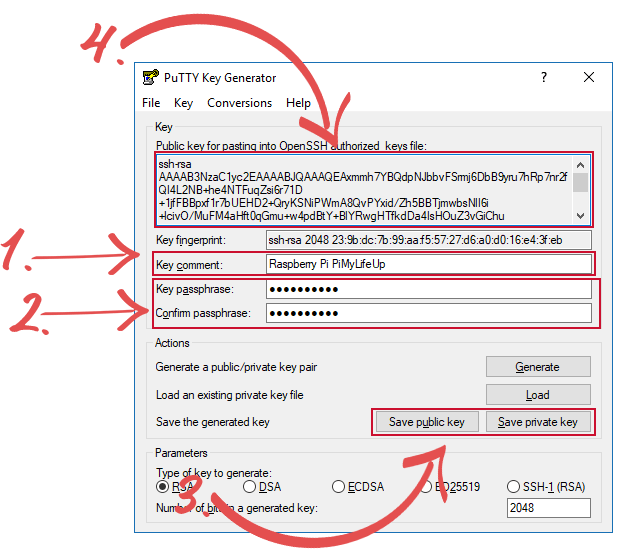I was just setting up my AWS CLI on a new Windows 10 machine and I ran into this error when trying to remote into my EC2 instance.
- Ssh Using Private Key Without File
- Linux Ssh Private Key File
- Ssh Private Key File Format
- Ssh Private Key File Permissions
- Ssh Using Private Key
The SSH-1 and SSH-2 protocols require different private key formats, and a SSH-1 key can't be used for a SSH-2 connection (or vice versa). Alternatively, you may have tried to load an SSH-2 key in a ‘foreign’ format (OpenSSH or ssh.com ) directly into one of the PuTTY tools, in which case you need to import it into PuTTY's native format.
These cannot be brute-forced – they are simply too complex. If you can, disable password logins in your “sshdconfig” file (on the server) and use keys instead. In case you travel and can’t carry your laptop with you, just keep your private key on a USB stick and attach it to your physical keychain. Wiindows terminal is proving to be an awesome tool for terminal(CLI) lovers. With its cusomization capabilities the possibilities are endless. Here in this article I'm going to explore connecting to a remote Linux server using SSH and private key using Windows Terminal.

This tutorial explains the Passwordless SSH using Public Key and Private Key in Linux. SSH stands for Secure SHELL, is a protocol used to connect remote hosts to login or performing some tasks using scripts. When we want to automate some tasks on remote hosts using scripts from a centralized server like Jenkins/Ansible. Connect to your instance using your existing private key file. Using a text editor of your choice, open the.ssh/authorizedkeys file on the instance. Paste the public key information from your new key pair underneath the existing public key information.
Ssh Using Private Key Without File
This is not related to AWS in any shape or form – it is a straightforward SSH requirement that is enforced on both Windows and Unix systems.
The issue is that we haven’t protected our private key file so if we’re going to use it to connect to an SSH endpoint then the OS forces us to conform to security standards by flagging up that UNPROTECTED PRIVATE KEY FILE error. Screen recording for mac book air.

Linux Ssh Private Key File

The solution is simple – we must fix exactly what it tell us to do in those bold capital letters. So let’s fix the security settings for our file.
The private key file that I’m trying to use as you may see from the screenshot is “ec2-demo.pem”. So we start by finding it in Windows Explorer.
Playstation remote play download windows 10. now right-click on it and go to “Properties” and then the “Security” tab and then click on “Advanced”.

On the Advanced tab we need to do the folowing:
- Make sure that you, the user who is logged in, is the file owner
- Disable inheritance. If it prompts you to remove all current inherited permissions then accept it.
- We need to give us Full Control. First, make sure that the Permission Entries panel is empty, i.e. there are no explicit permissions set. Then click on Add, then click on Select a Principal at the top and then click on “Advanced” and use “Find Now” to find the user you are logged in as. Once you find it, tick the Full Control box and click ok.
Close all windows and try running your SSH command again. It should work now.
Ssh Private Key File Format
If it doesn’t, here’s the check list: double check that you are the owner of the file, that you have Full Control permissions assigned and finally that there are no other permissions set except the one giving you full control.
Sonic r game free download pc full version. I was just setting up my AWS CLI on a new Windows 10 machine and I ran into this error when trying to remote into my EC2 instance.
This is not related to AWS in any shape or form – it is a straightforward SSH requirement that is enforced on both Windows and Unix systems.
The issue is that we haven’t protected our private key file so if we’re going to use it to connect to an SSH endpoint then the OS forces us to conform to security standards by flagging up that UNPROTECTED PRIVATE KEY FILE error.
The solution is simple – we must fix exactly what it tell us to do in those bold capital letters. So let’s fix the security settings for our file.
The private key file that I’m trying to use as you may see from the screenshot is “ec2-demo.pem”. So we start by finding it in Windows Explorer.
now right-click on it and go to “Properties” and then the “Security” tab and then click on “Advanced”.
On the Advanced tab we need to do the folowing:
Ssh Private Key File Permissions
- Make sure that you, the user who is logged in, is the file owner
- Disable inheritance. If it prompts you to remove all current inherited permissions then accept it.
- We need to give us Full Control. First, make sure that the Permission Entries panel is empty, i.e. there are no explicit permissions set. Then click on Add, then click on Select a Principal at the top and then click on “Advanced” and use “Find Now” to find the user you are logged in as. Once you find it, tick the Full Control box and click ok.
Ssh Using Private Key
Close all windows and try running your SSH command again. It should work now.
If it doesn’t, here’s the check list: double check that you are the owner of the file, that you have Full Control permissions assigned and finally that there are no other permissions set except the one giving you full control.
